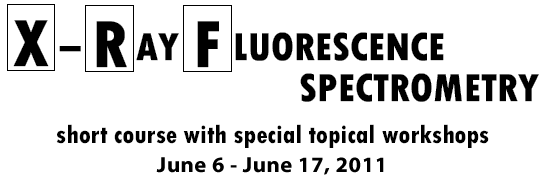
The course is following an integrated concept of alternating lectures, hands on sessions as well as practical exercises. To measure progress and ensure all participants have understood important concepts, quick tests and quizzes are also included in the curriculum. Each week is concluded with a course attendance and performance certificate, which is well respected in industry.
Week I - Fundamentals, Instrumentation and Qualitative Analysis
It is open to all who are working or intend to work in X-ray spectrometric analysis. No previous knowledge or background in X-ray spectrometry is required.
Topics to be covered in Week I:
Day 1
- Introduction to X-rays; Properties of X-rays
- Origin of X-ray Spectra; Excitation and Characteristic Radiations
- Instrumentation Part I: Introduction of WDXRF, EDXRF and Detectors
- Practical Exercise: Instrumentation and X-ray Source
- Source Spectra: what will excite our sample?
- Introduction to a WDXRF and an EDXRF Spectrometers
- Instruments Live Demo
Day 2
- Instrumentation Part II: Dispersion of X-ray; Pulse Height Analysis
- Practical Exercise: Qualitative Analysis, Spectral Identification – WDXRF & EDXRF
- Introduction to Matrix Effects Part I: Absorption; Mass Absorption Coefficients
- Practical Exercises: Working with Mass Absorption Coefficients (MACs)
Day 3
- Introduction to Matrix Effects Part II: Enhancement; Particle Size, Chemical and Mineralogical Effects; Surface Effects and Infinite Thickness
- Practical Exercise: Where does the signal come from - Infinite or non infinite thickness?
- Introduction to Quantitative Analysis: Counting Statistics; Figure of Merits; Correction for Spectral Interferences; Calibration and Standardless Analysis
- Practical Exercise: Source of Error; Counting Statistic- Precision/ Accuracy/ Bias
- Practical Exercise: My first calibration
Day 4
- Application Methods Maintenance: Drift Monitors; Drift Correction; Quality Control (QC)
- Practical Exercise: Counting Statistics and SPC Charts
- Best Operation Practice: WDXRF, EDXRF and related Analytical Issues
- Group Discussion: Analytical and Calibration issues with Practical Examples
- Summary of Advantages and Disadvantages of XRF Spectrometry
Day 5 – Sample Preparation Workshop
- Representative Sampling
- Specimen Preparation: Crushing & Milling
- Pressed Powder Briquettes
- Surface Preparation for Metals Samples
- Preparation for Liquid Samples
- Borate Fusion Technique
Week II - Quantitative Analysis and Method Development
Week II is in a NEW format, concentrating on the practical Method Development aspect for new applications. The approach is following GLP guidelines and enriched with many real world examples from the experience of the lecturers. The aim is to ingrain the steps, thus giving the participants a framework and successful tools. Once completed, the participants will be more successful in developing methods and able to deliver better methods in a short time!
Week II is built on the fundamentals of XRF from Week I. Because of the intense and demanding nature of the program, prior attendance at Week I is required. In exceptional circumstances a participant may be accepted where their background and experience are considered equivalent.
Topics to be covered in Week II:
Day 1
- What do we know so far: Recalling Week I
- Quantitative Analysis
- Define the Application: Get your specification right at the beginning!
- Sample Preparation Method: What is the BEST for your sample (matrix)?
- Availability of Standard Reference Materials
- Select Instrumental Parameters
- Use Figure of Merits and Optimize Pulse Height Analysis
- Practical Exercise:
- Figure of Merits for a WDXRF Instrumental Settings
- Figure of Merits for an EDXRF Instrumental Settings
Day 2
- Quantitative Analysis (cont'd)
- Measuring Standards and Define the Drift Correction
- Getting the Correct Intensities
- From Intensity to Concentration: KIM Equation; Matrix Correction Term and Algorithms
- Practical Exercise:
- Determining Net Intensities, including Background and Spectral Interference Corrections
- Trace Element Calibration: How to use ratio to Compton Peak Intensity
Day 3
- Quantitative Analysis (Matrix Correction)
- Fundamental Parameter (FP) Method I: X-ray Fundamental Parameters
- Fundamental Parameter (FP) Method II: Algorithms and Derivations
- Fundamental Parameter (FP) Method III: Applying the FP Method in Calibration Process
- Practical Exercises and Lectures are concurrent to reinforce each FP aspect step by step.
Day 4
- Introduction to Influence Coefficients
- Practical Exercise: Calculation and Validating the Case Study of a Ternary System
- Quality Assurance Samples and their limitations
- Q/A and Discussion: Problem encountered in Your Lab
Day 5 – Portable XRF Analyzer Workshop: Analysis and Interpretation of XRF Data from Non-uniform Objects
- Components of a Typical Portable XRF Analyzer
- Identify the X-ray Emission Lines and Qualitative Analysis
- Source of Errors / Sample Preparations
- Optimizing Analysis
- Spectral Interpretation and Analysis
- Calibration Process and Quantification
- Pitfalls and Realities of using a Portable XRF Analyzer
- Field Analysis and Case Studies
- Practical Exercises - Knowing the SPECTRA Software
- Radiation Safety
Also from this web page:
Registration
XRF2011 Short Course
Sample Prep Workshop
Portable XRF Analyzer Workshop
Contact
Course Coordinator:
Charles Wu (ctwu@uwo.ca)

